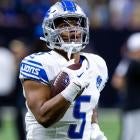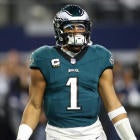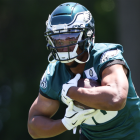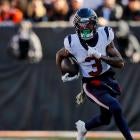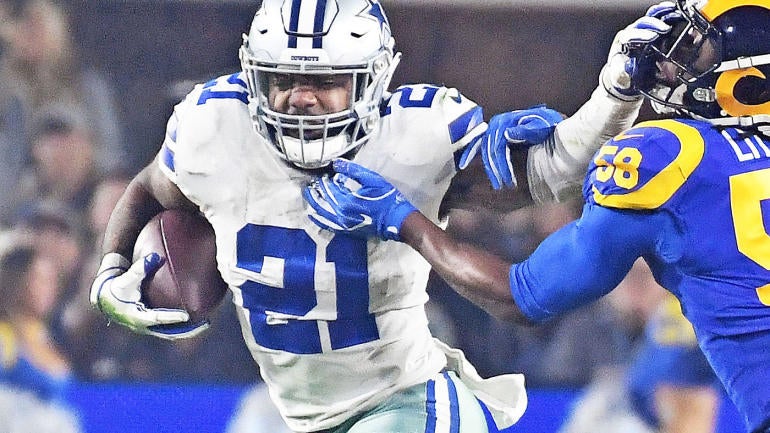
The Coronavirus pandemic is, obviously, much bigger than Fantasy Football. Separately, we at CBS Fantasy are trying to prepare you for your Fantasy Football leagues. And for us to accomplish that, we of course need to discuss what the Fantasy Football impact is as we prepare for what figures to be the most uncertain NFL season ever.
We've already done this a few different ways, including tracking all the opt outs and players placed on the COVID-19 reserve list. Earlier in the offseason, and then recently updated, Heath Cummings shared some prescient thoughts on how the pandemic could impact certain types of players. His points that rookies could be behind early in the season with the shortened preseason have become widely accepted and reflected in Average Draft Positions.
I want to talk about draft strategy, because there is one substantial way I am altering my approach to drafts due to COVID-19. To start, we have to lay down a couple of things I believe strongly and have written about before:
- Running backs are more fragile picks in the early rounds, which is to say they are at a greater risk of busting. This is reflected both in high injury rates but also in the reality that to be a highly valuable Fantasy running back, a player probably has to dominate the snaps and touches on his team. There are a variety of ways situations can change, but a player like David Johnson in 2019 is an example of how quickly a reasonably valuable Fantasy back can become unstartable. Not every back will see their team acquire a replacement via trade, but there are a variety of ways a lead back can lose an iron grip on backfield snaps and touches in a way that dramatically changes their Fantasy value. We just don't see that as frequently at other positions.
- As I wrote about last year, there is a period in drafts from the tail end of Round 3 or the start of Round 4 through the later single-digit rounds that has provided very little running back upside through the years, a draft range we've called the Running Back Dead Zone. In fact, the rate of elite RB seasons in this range is essentially on par with the rate for running backs drafted in the double-digit rounds.
With regards to the Dead Zone specifically, I've argued backs in this range are boosted in drafts because of their perceived safety, which is to say, they project for a lot of touches. I've further argued that running back projections can be very misleading, specifically in this range. That's because when you do a projection, you're almost obligated to make a best guess about which back will lead the backfield. And even though every season we see several teams have different lead backs at different times whether due to injury or ineffectiveness, because you have to project someone to lead a backfield, that player is typically going to look like a 200-plus touch guy.
The way I've typically thought about this is that there are 32 teams, and the top 15 or so running backs in Fantasy drafts — all of whom typically go in the first or second round — are those players who we feel most confident will dominate touches and be guys you want on your Fantasy rosters. Maybe it's the top 20 backs some years.
But that leaves roughly half of the league, or at least a dozen teams. These are the teams where the collective or crowd is less confident about the backfield split. But, because of the influence projections have and a degree of unwarranted certainty we have each August, the projected lead backs for almost all of those teams wind up getting drafted at least in the top 35 or 40 running backs. Fantasy drafters take backs who should be the lead guy in their backfield, because it's comforting to think you've locked in some touches.
In any given season, drafting these players is probably not a great strategy. The net result is often a player whose best-case scenario is being a solid producer who returns something close to ADP value, while the worst case is you can't use that player in your lineups. While that might seem like a reasonable bet given the difficulty of finding consistently productive running backs in Fantasy, the problem is opportunity cost — these backs are pushed up into a draft range alongside wide receivers with far stronger floor-to-ceiling profiles, who are much better picks for your roster. They also go alongside the elite or second tier quarterbacks and tight ends. That low-upside bet can cost you a shot at a real difference-maker elsewhere.
This is the basis for why we at CBS Fantasy have been hammering home the idea of grabbing an early RB or two if you can, then really building out some WR depth where it's strong and deep in the middle rounds. It also dovetails with the theory behind the Zero RB draft strategy, and Heath laid out why Zero RB is still very viable in 2020 here.
While you may or may not totally buy into these premises, what is clear about the potential impact of COVID-19 is it will only exasperate these phenomena. To whatever extent you do think running backs are pushed up in Fantasy drafts because of perceived opportunity that may not be bankable, you should recognize that in 2020, that opportunity will be less bankable than ever.
Playing time is key for all positions in Fantasy, but running back is easily the most opportunity-dependent position in Fantasy. Wide receivers and tight ends tend to earn targets rather than be handed them, and there are several on each team in a pecking order where if a player gets injured, everyone typically moves up a rung. If Amari Cooper misses time, we'll boost up Michael Gallup and CeeDee Lamb and Blake Jarwin before some backup who suddenly gets to see more snaps. If a running back misses time, and especially if their backup has a shot to dominate the touches, that player can go from a complete afterthought to a literal RB1 in a matter of a week's time. As I write this, James Conner and before him DeAngelo Williams come to mind as replacements for Le'Veon Bell, but the examples are endless.
And when we think about ways in which the NFL season could be impacted by COVID-19, we have to consider that this season more than any other, there will be these late-round running backs who are thrust into larger opportunities. Likewise, backs — like David Johnson in 2019 — who are relied upon largely for the projected stability of their touches, will lose those touches at a higher rate.
I keep referring to Johnson because he was pretty poor by any rushing measure last year, but was effective enough as a receiver to still be very solid for Fantasy early in 2019. But when an injury opened up snaps for a backup, Arizona watched as Chase Edmonds exploded and then eventually acquired Kenyan Drake.
It's not as cut and dried as "my player might miss a few weeks, but there's no way of knowing who it will hit and eventually he'll be back in his old role." Specifically with running backs, the risk is that a team sees something in the backup that materially alters the projected role of the previous starter. If David Montgomery starts slow again in 2020 then misses a few weeks and the Bears find their offense is running just as well or better without him, there's a threat he wouldn't return to the same opportunity. If Chris Carson misses time and Carlos Hyde rushes as efficiently as he did in Houston last year, Seattle could opt to split that role once Carson is back healthy.
I'm just throwing out examples, but the impact on draft strategy is, to me at least, obvious. Drafting a running back based on a perceived strong workload has never been more precarious, especially when many of those backs will cost you a shot at a high-end difference-maker at a different position. And then, the inverse — we will likely see more late-round running backs see their projected circumstances materially improve throughout the 2020 season than in any other.
That means, particularly early in drafts, you shouldn't build a running back heavy roster. I'll still target the ones I trust early, and those players probably deserve a boost because a guy like Christian McCaffrey through even someone like Josh Jacobs is not likely at any risk of losing significant opportunity if they have to miss a couple of weeks.
But in every draft I do in 2020, I'm looking to enter Round 8 or Round 9 with more wide receivers than running backs, and sometimes significantly more. I frequently draft backup wide receivers before filling my starting RB slots, because I also want depth there in case players miss time, but I'm much more confident those wide receivers will retain value even if they miss a few weeks.
And I'm more than fine taking a shot on an early-round tight end or even a quarterback in about Round 7 if I can get a guy in the Kyler Murray, Dak Prescott, Russell Wilson and Deshaun Watson tier. The net result when I build my roster this way is I take a lot of later-round RBs, and while I can't be certain any of them will catch a break and my roster looks thin at that position on paper, it leaves me with several bites at an apple that as a collective group I think has the best opportunity to gain value in the 2020 season.
If you've been hesitant to try Zero RB or a version of it like Modified Zero RB with one early running back, 2020 is the season to do it. All the arguments about running back fragility couldn't be more important to understand for this season. But even if you don't want to go that far, I implore you to not go the opposite direction and draft too many early running backs. It may feel like you're building depth, but it's a middle-of-the-pack strategy that leaves you weak at other positions and all but accepts you'll lose substantial value on at least one or more high-value picks.
Which players are poised for breakouts, which sleepers do you need to jump on, and which busts should you avoid at all costs in your Fantasy football league? Visit SportsLine now to get early rankings, plus see which WR is going to come out of nowhere to crack the top 10, all from the model that out-performed experts big time last season.











